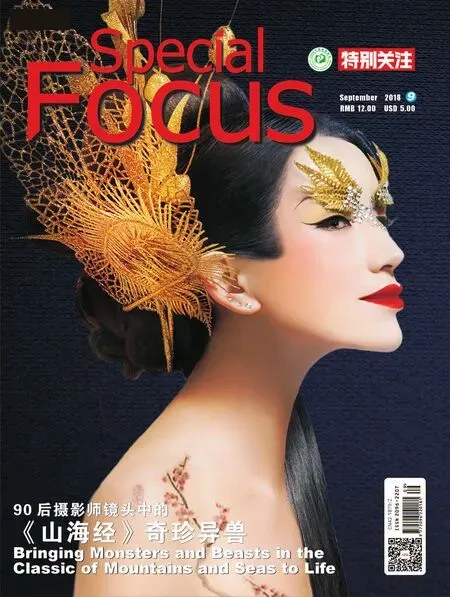How King Lear Was Embroidered?
2018-10-15ByZhouXianxian
By Zhou Xianxian
Picture a portrait of an old man with bushy white hair and a tidy white beard.His creased face with vivid and natural expression. What’s more,a striking Chinese character of“ 王 ” (the king) is stitched on his forehead and his glaring eyes force viewers to hold him in awe.We dare not to look at him for long, completely forgetting this is just an art of embroidery.
It is King Lear, a brilliant handcraft by Yang Xiaoting, a master of Han Embroidery in Hubei Province.
Both Yang’s maternal and paternal grandmothers were good at embroidering. In fl uenced by them, Yang was interested in embroidery when she was very young. As time went by, her interest turned to a deep love for embroidery. She has devoted herself to Han Embroidery for thirty years.
Yang’s mother, who is a Christian, often brought her to the church in her childhood. Seeing the furnishings there, she gradually fell for Western art. Afterwards, she received a systemic education on traditional Chinese painting and oil painting at an art college in Hubei and mastered Eastern and Western aesthetic theories. Along with an open attitude towards pursuing art,Yang has learned a lot from both Western and Chinese cultures. As a cross between Chinese and Western art, most of her works show extraordinary beauty.
Yang Xiaoting and her talented team created King Lear in 2014.It took almost eight months to finish it. The prototype of this embroidery is a staged photo of Wu Xingguo, the Taiwanese playwright of the Peking Opera Lear Is Here, which was adapted from Shakespeare’s drama King Lear. Wu innovatively interpreted this drama in the form of Chinese Peking Opera.
At that time, Yang Xiaoting was striving to figure out how to combine Han Embroidery with fiber art. She came across the stage photo of Wu in a magazine and she was inspired to transform it into embroidery.
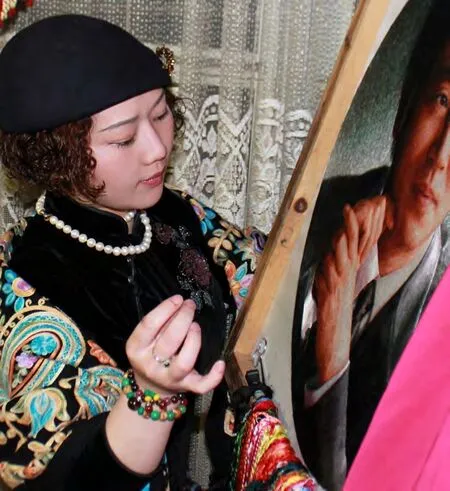
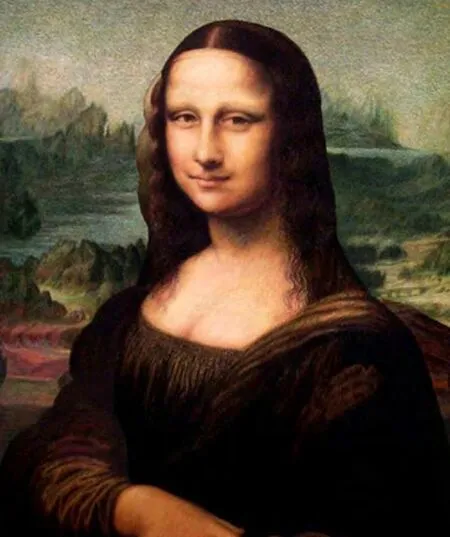
It took a lot of time and effort to complete the primary design of this work, including adoption of stitches and adjustments of color and brightness, according to Yang Xiaoting. In order to highlight the characteristics of King Lear, Yang used free stitching to embroider his face, so that threads can flow along his facial outline and create a visual effect of oil paint. Given the costume style of Peking Opera and avoiding his face being overshadowed by the pattern stitched by gold threads on his clothes, Yang embedded black threads into the gold ones properly to adjust the brightness of different parts. Traditional circling gold stitch and modern free stitch, a figure of western drama presented as a Peking Opera character, along withfiber art—every detail of this seemingly simple work manifests the creator’s originality.
Yang Xiaoting has created a number of embroideries on the basis of paintings by Monet and Van Gogh using different stitches, as well as a series of works based on portrayals of Western musicians, which she hopes to show the world when her daughter holds piano concerts overseas in the future.
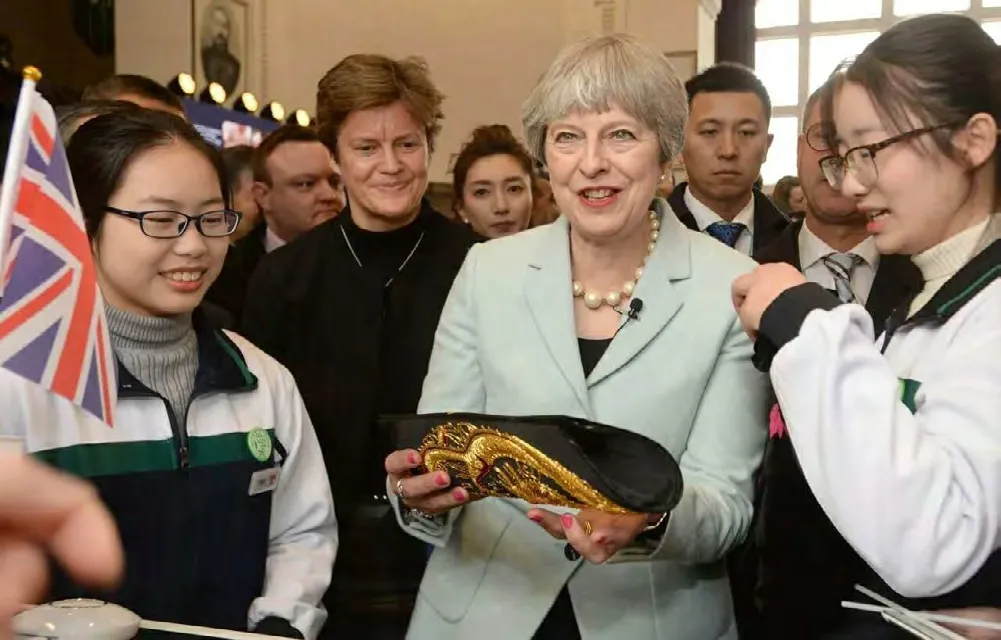
英国首相特蕾莎·梅对“龙凤呈祥坤包”爱不释手Wallet embroidered by Yang Xiaoting presented to Teresa May, British Prime Minister, as a gift
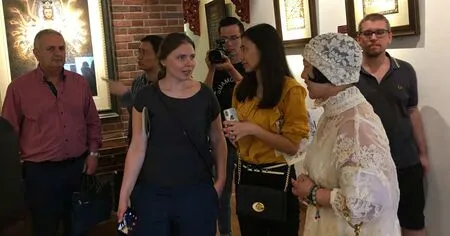
杨小婷在给海外大V讲解汉绣作品Yang Xiaoting explaining Han embroidery to overseas Internet celebrities
Yang likes reading Shakespeare’s dramas and she often reads with her daughter,playing different roles. Yang said the poem Nine Tunes by Chinese poet Qu Yuan is also rich in such splendid and romantic scenes,and she wants to bring more Chinese cultural elements to her embroideries to share with more people outside of China.
Yang Xiaoting insists on the idea of fusion of Chinese and Western styles during her creation, which gives Han Embroidery, with a history of over 2300 years, a new life. So far, she has received visitors from dozens of countries, and her embroideries have been presented to foreign celebrities many times,including Theresa Mary May and Bill Gates.
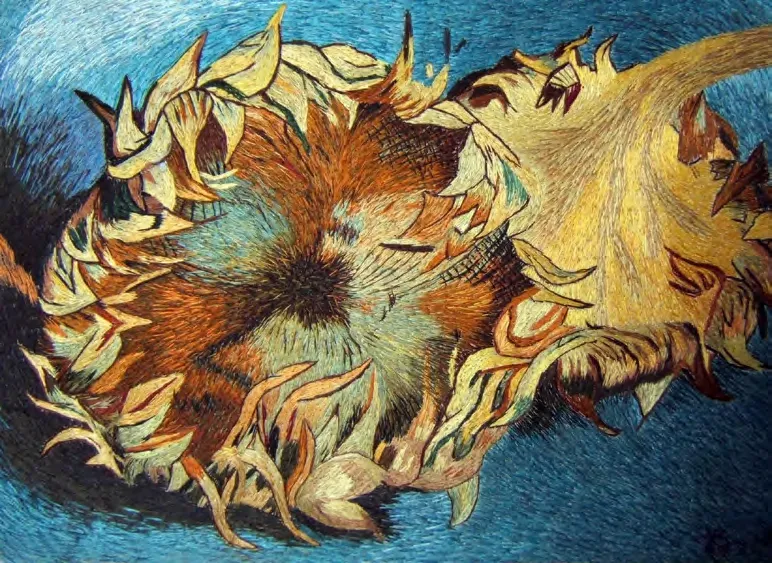
杨小婷作品《向日葵》Sunflower, an embroidery work by Yang Xiaoting
头上蓬松飘逸的白发,耳边挂着整齐的连腮长髯,中间一张略敷脂粉的脸,脸上表情生动自然,依稀可见老者的皱纹。这老者额头上赫然写着一个“王”字,怒目圆睁,让人顿生敬畏,忘了眼前只是一幅绣品,竟不敢长时间与之对视……
这便是湖北省汉绣大师杨小婷的佳作《李尔王》。
杨小婷的奶奶、姥姥都会绣花,杨小婷自小受她们的影响,对刺绣很感兴趣,而这份兴趣慢慢演变成热爱,一直延续至今,转眼针耕已有三十年。
妈妈是基督徒,常带她去教堂。看多了教堂里的陈设,她也慢慢喜欢上西方艺术。后来,她在美院系统地学习了国画和油画,东西方美术理论尽在掌握中。加上她追求艺术的开放态度,使她在中西文化中汲取了大量养分,她的很多作品都是中西融合,大放异彩。
《李尔王》是杨小婷和她的精英团在2014年一起创作的,前后花了七八个月时间。这幅作品以台湾剧作家吴兴国改编京剧《李尔在此》中李尔王的剧照为原型。吴兴国曾大胆地将莎士比亚戏剧用京剧的方式演绎出来。
当时,杨小婷正在寻找将汉绣与纤维艺术结合在一起的方法,她偶然在杂志上看到了这张剧照,其创新理念和自己不谋而合,便决定以此作为刺绣题材。
据杨小婷介绍,这幅绣品在前期设计时花了不少心思,比如针法的选择、颜色和亮度的调整等。为了更加突出人物特征,杨小婷在脸部采用游针绣,使绣线顺着脸部线条流动,营造油彩的视觉效果。为了符合京剧服装风格,又不让服装上的盘金盖过人物的脸部,杨小婷在使用盘金绣时,在金线中编入不同密度的黑线,以协调绣品不同部位的亮度。针法的古今结合,题材上的中西融合,外加纤维艺术,一幅看似简单的作品,每一处细节都体现了作者的独具匠心。
杨小婷先后用不同的针法绣了莫奈、梵高等人的画作,还绣了一系列西方音乐家的画像,她希望这些作品日后能随女儿去国外办钢琴音乐会时展出。
杨小婷喜欢读莎士比亚戏剧,她经常和女儿一起分角色朗读,兴致高的时候还会演上几幕,母女俩其乐融融。杨小婷说中国诗人屈原的《九歌》里,有很多场景唯美浪漫,她希望把更多中国文化元素绣入其作品中,带到西方共赏。
杨小婷在绣品中体现的中西融合的理念,使具有2300多年历史的汉绣非遗文化绽放出时代生机。截至目前,她已接待过来自几十个国家的参观者。她的绣品多次作为礼物赠送给外国友人,英国首相特蕾莎·梅和世界名人比尔·盖茨等都在其列。
